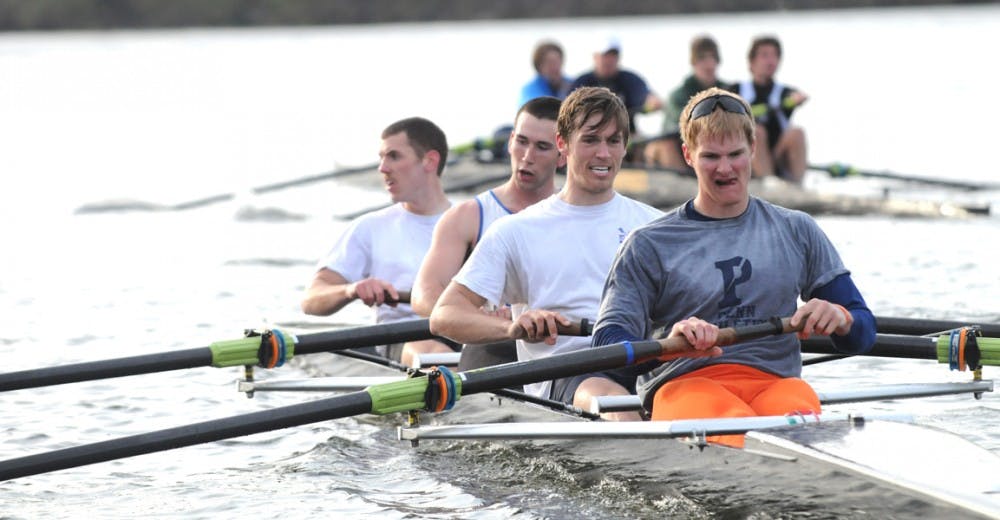
I sat in a warm, red-carpeted office in Dunning Coaches’ Center, just outside of Franklin Field. It was about 2 p.m. on a cloudy Thursday, and coaches James Sands and Ed Golding of the men’s heavyweight rowing team stood opposite me. We talked, joked and reminisced for a while before Golding dropped a minor bombshell: “So when will we see you on the team again?”
It was a loaded question. I was an ex-rower who was a member of the freshman heavyweight team all last semester. I learned with these people — traveled, ate, studied, woke up and went to sleep with these people. I pushed myself further than I ever thought possible.
It was a tough question, and it was all I could do to divert it with a laugh. “We’ll see,” I said.
The coaches, meanwhile, were cognizant of the debate going on in The Daily Pennsylvanian about the rowing team and its high drop rate.
“It’s tough,” Golding admitted. “It’s a big university, lots to do. At some point, people might think they don’t enjoy this as much and would enjoy doing something else.”
What’s remarkable about rowing is the number of newcomers the sport pulls in the first few weeks of school. It is the quintessential intercollegiate sport — especially at Penn.
“Rowing is one of the few sports at Penn where a person who’s never done it before can become a top-eight rower,” Golding said.
“If we can tap into really competitive guys who don’t have rowing experience, we’ll absolutely do that,” Sands said. “The varsity eight last year had two walk-ons. The commodore [a leader on the team] last year was a walk-on.”
The hardest part about rowing might be the season’s length — it’s a double season sport that has an “offseason” in winter. The offseason really just means less practice time. An average 15-hour week of practice drops to just six hours. Ivy League rules dictate a maximum of six hours per week during the offseason, but that’s still enough hard work to wear on any person.
“You’re dealing with an outdoor season being indoors most of the time and it’s tough,” Golding said of the winter season.
For the athletes, it’s even tougher in the winter because “the reason most people row is to get out onto a boat and go hard,” Sands said.
The coaches told me about that day’s practice for the team.
“The freshmen will be doing a light erg [a rowing machine], just half an hour or so. It’ll be easy,” Golding said. “They’ve got a hard day tomorrow.”
I agreed to meet them at the stadium ergometer room at Franklin Field to observe.
As I entered, the team was sitting on their ergs, facing a blank wall in an unnamed hallway under Franklin Field.
The workout that day was mostly sprints on the erg, where rowers would pull the handles of the machine at a rapid pace. Their workout was to last for half an hour.
I arrived just as the workout began, and like the schedule dictated, the first few minutes were uneventful. The exercise for the freshman rowers that day would be hard for an outsider, but for anyone with a modicum of rowing experience, it’s easy. The coaches used to say that the team should be able to do these forever.
Ten minutes in, though, the workout turned into a different animal. The rowers all let loose, and the hallway— before noiseless — was a cacophony of roaring encouragements, whirring fans and grunting athletes. In the sprints, the fastest, like College freshmen Clay Censits and Peter “Bear” St. Michael and Wharton freshman Alex Buck were pulling 1:17 splits — meaning that they would be able to row 500 meters in 1:17.
I went up to the rest of the team members who weren’t on the ergs and asked if 1:17 splits were “the rowing world’s version of the four-minute mile.” College freshman Zac Endter said, “No, that’s not nearly fast enough.”
Fifteen minutes in, the exhaustion was showing. The rowers were doubled over and panting in their 90 second rests. Split times rose, and the best were doing 1:20s.
The cycle of terrifying shouts and quick recovering breaths continued for another 15 minutes, when the last of the fans on the machines stopped whirring. The team had survived a “light erg.”
It’s been said that conflict and a huge time commitment make rowing at Penn difficult to commit to.
After the workout, College freshman Jared Levin offered his take on rowing life:
“It forces you to compete with your good friends all the time. Out of that comes a competitive spirit and an occasional conflict.”
Stronger than any of those, though, is the team’s commitment to each other.
“All that hard work brings people together,” Golding said.
And College freshman Jakub Dziedzic expressed the spirit of camaraderie best when, at the workout’s end, he said, “Are we going to Hill for dinner?”
SEE ALSO
For Penn women’s rowing, talent is hard to keep
Penn rowing to perform for the masses
Penn rowing starts season on high at Navy Day Regatta
Penn crews to compete in annual Navy Day Regatta
The Daily Pennsylvanian is an independent, student-run newspaper. Please consider making a donation to support the coverage that shapes the University. Your generosity ensures a future of strong journalism at Penn.
DonatePlease note All comments are eligible for publication in The Daily Pennsylvanian.





